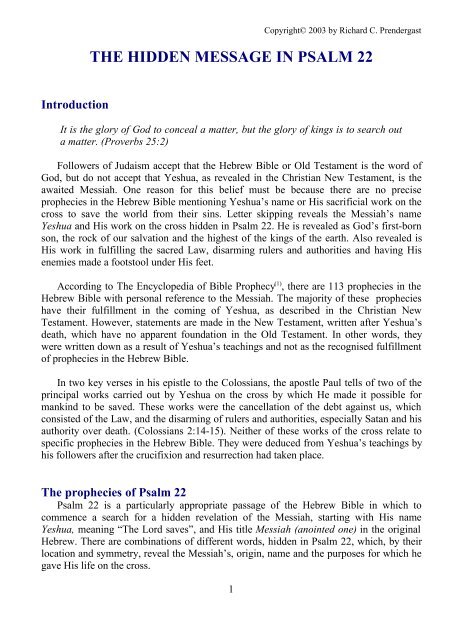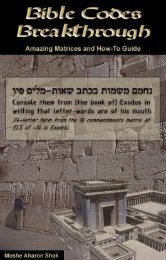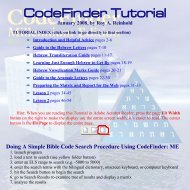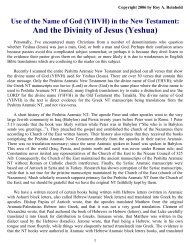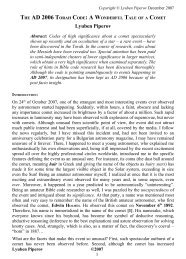The Hidden Message in Psalm 22 - Codes in the Bible
The Hidden Message in Psalm 22 - Codes in the Bible
The Hidden Message in Psalm 22 - Codes in the Bible
Create successful ePaper yourself
Turn your PDF publications into a flip-book with our unique Google optimized e-Paper software.
Introduction<br />
Copyright© 2003 by Richard C. Prendergast<br />
THE HIDDEN MESSAGE IN PSALM <strong>22</strong><br />
It is <strong>the</strong> glory of God to conceal a matter, but <strong>the</strong> glory of k<strong>in</strong>gs is to search out<br />
a matter. (Proverbs 25:2)<br />
Followers of Judaism accept that <strong>the</strong> Hebrew <strong>Bible</strong> or Old Testament is <strong>the</strong> word of<br />
God, but do not accept that Yeshua, as revealed <strong>in</strong> <strong>the</strong> Christian New Testament, is <strong>the</strong><br />
awaited Messiah. One reason for this belief must be because <strong>the</strong>re are no precise<br />
prophecies <strong>in</strong> <strong>the</strong> Hebrew <strong>Bible</strong> mention<strong>in</strong>g Yeshua’s name or His sacrificial work on <strong>the</strong><br />
cross to save <strong>the</strong> world from <strong>the</strong>ir s<strong>in</strong>s. Letter skipp<strong>in</strong>g reveals <strong>the</strong> Messiah’s name<br />
Yeshua and His work on <strong>the</strong> cross hidden <strong>in</strong> <strong>Psalm</strong> <strong>22</strong>. He is revealed as God’s first-born<br />
son, <strong>the</strong> rock of our salvation and <strong>the</strong> highest of <strong>the</strong> k<strong>in</strong>gs of <strong>the</strong> earth. Also revealed is<br />
His work <strong>in</strong> fulfill<strong>in</strong>g <strong>the</strong> sacred Law, disarm<strong>in</strong>g rulers and authorities and hav<strong>in</strong>g His<br />
enemies made a footstool under His feet.<br />
Accord<strong>in</strong>g to <strong>The</strong> Encyclopedia of <strong>Bible</strong> Prophecy (1) , <strong>the</strong>re are 113 prophecies <strong>in</strong> <strong>the</strong><br />
Hebrew <strong>Bible</strong> with personal reference to <strong>the</strong> Messiah. <strong>The</strong> majority of <strong>the</strong>se prophecies<br />
have <strong>the</strong>ir fulfillment <strong>in</strong> <strong>the</strong> com<strong>in</strong>g of Yeshua, as described <strong>in</strong> <strong>the</strong> Christian New<br />
Testament. However, statements are made <strong>in</strong> <strong>the</strong> New Testament, written after Yeshua’s<br />
death, which have no apparent foundation <strong>in</strong> <strong>the</strong> Old Testament. In o<strong>the</strong>r words, <strong>the</strong>y<br />
were written down as a result of Yeshua’s teach<strong>in</strong>gs and not as <strong>the</strong> recognised fulfillment<br />
of prophecies <strong>in</strong> <strong>the</strong> Hebrew <strong>Bible</strong>.<br />
In two key verses <strong>in</strong> his epistle to <strong>the</strong> Colossians, <strong>the</strong> apostle Paul tells of two of <strong>the</strong><br />
pr<strong>in</strong>cipal works carried out by Yeshua on <strong>the</strong> cross by which He made it possible for<br />
mank<strong>in</strong>d to be saved. <strong>The</strong>se works were <strong>the</strong> cancellation of <strong>the</strong> debt aga<strong>in</strong>st us, which<br />
consisted of <strong>the</strong> Law, and <strong>the</strong> disarm<strong>in</strong>g of rulers and authorities, especially Satan and his<br />
authority over death. (Colossians 2:14-15). Nei<strong>the</strong>r of <strong>the</strong>se works of <strong>the</strong> cross relate to<br />
specific prophecies <strong>in</strong> <strong>the</strong> Hebrew <strong>Bible</strong>. <strong>The</strong>y were deduced from Yeshua’s teach<strong>in</strong>gs by<br />
his followers after <strong>the</strong> crucifixion and resurrection had taken place.<br />
<strong>The</strong> prophecies of <strong>Psalm</strong> <strong>22</strong><br />
<strong>Psalm</strong> <strong>22</strong> is a particularly appropriate passage of <strong>the</strong> Hebrew <strong>Bible</strong> <strong>in</strong> which to<br />
commence a search for a hidden revelation of <strong>the</strong> Messiah, start<strong>in</strong>g with His name<br />
Yeshua, mean<strong>in</strong>g “<strong>The</strong> Lord saves”, and His title Messiah (ano<strong>in</strong>ted one) <strong>in</strong> <strong>the</strong> orig<strong>in</strong>al<br />
Hebrew. <strong>The</strong>re are comb<strong>in</strong>ations of different words, hidden <strong>in</strong> <strong>Psalm</strong> <strong>22</strong>, which, by <strong>the</strong>ir<br />
location and symmetry, reveal <strong>the</strong> Messiah’s, orig<strong>in</strong>, name and <strong>the</strong> purposes for which he<br />
gave His life on <strong>the</strong> cross.<br />
1
Accord<strong>in</strong>g to Christian <strong>the</strong>ology, prophecies found <strong>in</strong> <strong>the</strong> open text of <strong>Psalm</strong> <strong>22</strong> were fulfilled<br />
at <strong>the</strong> crucifixion. Every sentence can be applied to Yeshua without stra<strong>in</strong><strong>in</strong>g its mean<strong>in</strong>g. David,<br />
<strong>the</strong> writer of <strong>the</strong> psalm anticipates Yeshua’s great cry of anguish as He hung on <strong>the</strong> cross, <strong>in</strong> <strong>the</strong><br />
open<strong>in</strong>g verse:<br />
“My God, My God, why hast Thou forsaken me?”<br />
Accord<strong>in</strong>g to Mat<strong>the</strong>w’s Gospel <strong>in</strong> <strong>the</strong> Christian New Testament, when Yeshua was hang<strong>in</strong>g<br />
on <strong>the</strong> cross, He spoke <strong>the</strong>se words <strong>in</strong> <strong>the</strong>ir Aramaic form (Mat<strong>the</strong>w 27:46). <strong>The</strong> Messiah was<br />
necessarily abandoned on <strong>the</strong> cross when He took <strong>the</strong> penalty for s<strong>in</strong>s of men upon himself.<br />
Mat<strong>the</strong>w 27:43 records <strong>the</strong> abusive comments of those who were pass<strong>in</strong>g by, thus fulfill<strong>in</strong>g<br />
verses 7 and 8 of <strong>Psalm</strong> <strong>22</strong>.<br />
<strong>The</strong> language <strong>in</strong> <strong>Psalm</strong> <strong>22</strong> used to describe <strong>the</strong> death struggle is appropriate to <strong>the</strong> suffer<strong>in</strong>g<br />
endured by Yeshua. <strong>The</strong> agony of crucifixion, a method of torturous execution attributed to <strong>the</strong><br />
Romans, exacerbated with thirst, asphyxiation and <strong>in</strong>tense pa<strong>in</strong> to <strong>the</strong> hands and feet, is<br />
prophetically described <strong>in</strong> verses 14-16. <strong>The</strong> fulfillment of this prophecy is related <strong>in</strong> all <strong>the</strong><br />
Gospels, especially John chapter 19.<br />
<strong>The</strong> Roman soldiers, who divided <strong>the</strong> Messiah’s garments and cast lots for his cloth<strong>in</strong>g (verse<br />
18), could not have had knowledge of <strong>the</strong> predictions <strong>in</strong> <strong>Psalm</strong> <strong>22</strong> written a thousand years<br />
beforehand. Nor would <strong>the</strong>y <strong>the</strong>n have known that <strong>the</strong> Messiah’s deliverance (verses 20 and 21)<br />
would be His resurrection from <strong>the</strong> dead, and that his work on <strong>the</strong> cross would save those who<br />
believed <strong>in</strong> Him from <strong>the</strong>ir s<strong>in</strong>s.<br />
Yeshua said:<br />
“All th<strong>in</strong>gs which are written about Me <strong>in</strong> <strong>the</strong> Law of Moses and <strong>the</strong> Prophets and <strong>the</strong><br />
<strong>Psalm</strong>s must be fulfilled.” (Luke 24:44)<br />
Who is <strong>the</strong> Messiah?<br />
God <strong>in</strong>spired David to write <strong>Psalm</strong> <strong>22</strong> <strong>in</strong> such a way as to hide <strong>the</strong> name, orig<strong>in</strong> and title of<br />
<strong>the</strong> One who was crucified. <strong>The</strong> key to <strong>the</strong> hidden prophecies <strong>in</strong> <strong>the</strong> <strong>Psalm</strong> is <strong>the</strong> name Yeshua<br />
Meshiach. God also left an illustration <strong>in</strong> <strong>the</strong> text alongside <strong>the</strong> hidden names and titles, which<br />
confirms <strong>the</strong> work <strong>the</strong> Messiah accomplished on <strong>the</strong> cross <strong>in</strong> break<strong>in</strong>g <strong>the</strong> curse of <strong>the</strong> Law. <strong>The</strong><br />
<strong>Bible</strong> code matrix shows <strong>the</strong> Law be<strong>in</strong>g cancelled out by <strong>the</strong> cross. Only someone liv<strong>in</strong>g <strong>in</strong> <strong>the</strong><br />
20 th century with access to a computer program could reasonably be expected to solve <strong>the</strong> hidden<br />
puzzle ly<strong>in</strong>g dormant <strong>in</strong> <strong>Psalm</strong> <strong>22</strong> for three thousand years.<br />
Yeshua and Meshiach are composed <strong>in</strong> Hebrew of four letters each. Computorah reveals<br />
many occurrences of <strong>the</strong>se two words, at low equi-distant letter <strong>in</strong>tervals, between 1 and 100,<br />
hidden <strong>in</strong> <strong>the</strong> <strong>Psalm</strong>s. This is to be expected. <strong>The</strong> Hebrew letters which make up Yeshua עושי<br />
and Meshiach חישמ all have a high frequency of usage and <strong>the</strong> probability of <strong>the</strong>ir regular<br />
occurrence is high. However, when <strong>the</strong> letters of <strong>the</strong> two words are comb<strong>in</strong>ed <strong>in</strong>to a str<strong>in</strong>g of<br />
eight letters, <strong>the</strong> probability of <strong>the</strong> occurrence of that str<strong>in</strong>g at a low equi-distant letter <strong>in</strong>terval,<br />
less than many thousands, is very low <strong>in</strong>deed. To f<strong>in</strong>d Yeshua Meshiach hidden, at a low equi-<br />
2
distant letter <strong>in</strong>terval, <strong>in</strong> one of <strong>the</strong> most relevant passages of scripture cannot be by chance. It is<br />
<strong>the</strong> only occurrence <strong>in</strong> <strong>the</strong> whole of <strong>the</strong> Hebrew <strong>Bible</strong>.<br />
Webmaster note: <strong>The</strong> follow<strong>in</strong>g is <strong>the</strong> statistically expected occurrences <strong>in</strong> a random<br />
Hebrew text of <strong>the</strong> same length as <strong>the</strong> Tanakh (Old Testament).<br />
ELS range 1 to 50 – 1 chance <strong>in</strong> 34.5 (1 actual f<strong>in</strong>d)<br />
ELS range 1 to 500 – 1 chance <strong>in</strong> 3.45 (2 actual f<strong>in</strong>ds)<br />
ELS range 1 to 5000 – expect to f<strong>in</strong>d 2.86 occurrences (5 actual f<strong>in</strong>ds)<br />
ELS range 1 to 50,000 – expect to f<strong>in</strong>d 24.7 occurrences (23 actual f<strong>in</strong>ds)<br />
It may be a bit of hyperbole (said unknow<strong>in</strong>gly) by Reverend Prendergast to state that it<br />
is <strong>the</strong> only occurrence <strong>in</strong> <strong>the</strong> Hebrew <strong>Bible</strong>.<br />
<strong>The</strong> eight Hebrew letter str<strong>in</strong>g חישמ עושי Yeshua Meshiach appears <strong>in</strong> <strong>Psalm</strong> <strong>22</strong> at a skip of<br />
45 letter <strong>in</strong>tervals, written reversed <strong>in</strong> Hebrew <strong>in</strong> relation to <strong>the</strong> open text, with <strong>the</strong> last letter of<br />
Meshiach be<strong>in</strong>g <strong>the</strong> 14 th letter of <strong>the</strong> first verse.<br />
In <strong>the</strong> matrix, o<strong>the</strong>r titles referr<strong>in</strong>g to <strong>the</strong> Messiah are found located close to Yeshua<br />
Meshiach when <strong>the</strong> letters of <strong>Psalm</strong> <strong>22</strong> are formed <strong>in</strong>to a matrix. <strong>The</strong> number of letters <strong>in</strong> each<br />
row of <strong>the</strong> matrix is made <strong>the</strong> same as <strong>the</strong> equi-distant letter <strong>in</strong>terval [45] for <strong>the</strong> eight letter<br />
str<strong>in</strong>g Yeshua Meshiach. <strong>The</strong> str<strong>in</strong>g appears vertically <strong>in</strong> <strong>the</strong> top centre of <strong>the</strong> matrix (<strong>in</strong> red).<br />
3
<strong>Psalm</strong> 89 and many o<strong>the</strong>r passages of scripture refer to <strong>the</strong> Lord of Hosts or Sabaoth be<strong>in</strong>g<br />
God’s name. <strong>The</strong> word sabaoth תואבצ (tz'va'ot) mean<strong>in</strong>g hosts crosses <strong>the</strong> word רוכב (b'kor)<br />
mean<strong>in</strong>g first-born, and both words have common letters with רוצ (tzur) mean<strong>in</strong>g rock. <strong>The</strong>se<br />
latter two words are taken from <strong>Psalm</strong> 89:26 and 27:<br />
He will cry to Me, “Thou art my fa<strong>the</strong>r, my God and <strong>the</strong> rock of my salvation.”<br />
I also shall make him My first-born, <strong>the</strong> highest of <strong>the</strong> k<strong>in</strong>gs of <strong>the</strong> earth.<br />
<strong>The</strong> word יתעושי (y'shu'ati) mean<strong>in</strong>g my salvation is found commenc<strong>in</strong>g at <strong>the</strong> 44 th letter of<br />
<strong>the</strong> pla<strong>in</strong> text of <strong>Psalm</strong> <strong>22</strong>. At <strong>the</strong> bottom of <strong>the</strong> matrix, <strong>the</strong> words ןוילע (elyon) �mean<strong>in</strong>g <strong>the</strong><br />
highest and ךלמ (melekh) mean<strong>in</strong>g k<strong>in</strong>g <strong>in</strong>tersect. Thus six words <strong>in</strong> <strong>Psalm</strong> 89, giv<strong>in</strong>g <strong>the</strong> titles<br />
and orig<strong>in</strong> of <strong>the</strong> Messiah, <strong>the</strong> Son of God, are revealed <strong>in</strong> <strong>the</strong> <strong>Psalm</strong> <strong>22</strong> matrix.<br />
<strong>The</strong> Messiah’s work on <strong>the</strong> cross<br />
In <strong>the</strong> years that followed, <strong>the</strong> events of <strong>the</strong> crucifixion were recorded <strong>in</strong> <strong>the</strong> Gospels.<br />
However it was <strong>the</strong> Apostle Paul, a Pharisee, who <strong>in</strong>terpreted <strong>the</strong> true mean<strong>in</strong>g of <strong>the</strong> work <strong>the</strong><br />
Messiah accomplished by His death on <strong>the</strong> cross.<br />
Paul was speak<strong>in</strong>g of Jews, liv<strong>in</strong>g under <strong>the</strong> Law (Torah), when he said:<br />
4
Bre<strong>the</strong>ren, my heart’s desire and my prayer to God for <strong>the</strong>m is for <strong>the</strong>ir salvation. For I<br />
bear <strong>the</strong>m witness that <strong>the</strong>y have a zeal for God, but not <strong>in</strong> accordance with knowledge.<br />
For not know<strong>in</strong>g about God’s righteousness, and seek<strong>in</strong>g to establish <strong>the</strong>ir own, <strong>the</strong>y<br />
did not subject <strong>the</strong>mselves to <strong>the</strong> righteousness of God. For <strong>the</strong> Messiah is <strong>the</strong> end of<br />
<strong>the</strong> Law for righteousness to everyone who believes.<br />
For Moses writes that <strong>the</strong> man who practices righteousness which is based on law shall<br />
live by that righteousness. (Romans 10:1-5)<br />
In his letter to <strong>the</strong> Galatians, Paul writes that, before <strong>the</strong> Law was given, Abraham believed<br />
God and it was reckoned to him as righteousness. Thus Abraham received salvation through<br />
righteousness. <strong>The</strong> Law is holy (Romans 7:12), but it became a curse to those who sought<br />
salvation through it, just as it is written <strong>in</strong> <strong>the</strong> Torah:<br />
Cursed is he who does not confirm <strong>the</strong> words of this Law by do<strong>in</strong>g <strong>the</strong>m. (Deuteronomy<br />
27:26)<br />
Rabbis have agreed that it is impossible to keep <strong>the</strong> Law and obta<strong>in</strong> salvation through it.<br />
Paul cont<strong>in</strong>ues his message to <strong>the</strong> Galatians writ<strong>in</strong>g:<br />
Now that no one is justified by <strong>the</strong> Law before God is evident; for, <strong>the</strong> righteous man<br />
shall live by faith, for <strong>the</strong> Law is not of faith. (Galatians 3:11-12).<br />
He fulfilled <strong>the</strong> Law<br />
Faith lead<strong>in</strong>g to eternal life is based on belief <strong>in</strong> <strong>the</strong> person of Yeshua, who broke <strong>the</strong> curse of<br />
<strong>the</strong> Law by complet<strong>in</strong>g His work on His cross.<br />
Paul expounds on <strong>the</strong> Messiah’s triumph over legalism <strong>in</strong> his letter to <strong>the</strong> Colossians:<br />
Hav<strong>in</strong>g cancelled out <strong>the</strong> certificate of debt consist<strong>in</strong>g of decrees aga<strong>in</strong>st us and which<br />
was hostile to us; He has taken it out of <strong>the</strong> way hav<strong>in</strong>g nailed it to <strong>the</strong> cross.<br />
(Colossians 2:14)<br />
<strong>The</strong> certificate of debt and its decrees refer to <strong>the</strong> Torah, which condemned mank<strong>in</strong>d <strong>in</strong>to<br />
debt to God through s<strong>in</strong>. <strong>The</strong> Messiah, <strong>in</strong> offer<strong>in</strong>g His body as a once and for all sacrifice for our<br />
s<strong>in</strong>, nailed <strong>the</strong> demands of <strong>the</strong> Law to <strong>the</strong> cross and <strong>the</strong>reby fulfilled <strong>the</strong>m. In o<strong>the</strong>r words: His<br />
cross crossed out <strong>the</strong> debt of <strong>the</strong> Torah.<br />
<strong>The</strong>se words are found hidden <strong>in</strong> <strong>Psalm</strong> <strong>22</strong>, written <strong>in</strong> such a way that exactly symbolises His<br />
purpose. <strong>The</strong> word His cross exactly crosses out Torah as shown. In <strong>the</strong> matrix, to <strong>the</strong> left of<br />
Yeshua Meshiach, <strong>the</strong> word Torah הרות commences from upper right, written <strong>in</strong> <strong>the</strong> correct<br />
direction <strong>in</strong> Hebrew. Commenc<strong>in</strong>g from bottom right <strong>the</strong> word translated His cross ובלצ<br />
(tz'lavo) diagonally crosses Torah with exact symmetry to <strong>the</strong> eight letter str<strong>in</strong>g Yeshua<br />
Meshiach. See <strong>the</strong> colour cod<strong>in</strong>g <strong>in</strong> <strong>the</strong> matrix to locate <strong>the</strong>se and o<strong>the</strong>r hidden words.<br />
5
<strong>The</strong> word His cross is taken from a Hebrew translation of Mat<strong>the</strong>w 27:32 (3) . It does not occur<br />
<strong>in</strong> <strong>the</strong> Hebrew <strong>Bible</strong> or Old Testament, crucifixion hav<strong>in</strong>g been <strong>in</strong>vented by <strong>the</strong> Romans. Before<br />
He was crucified, Yeshua said:<br />
Not <strong>the</strong> smallest letter or stroke shall pass away from <strong>the</strong> Law until all is accomplished.<br />
(Mat<strong>the</strong>w 5:18)<br />
He disarmed <strong>the</strong> rulers<br />
Paul cont<strong>in</strong>ues <strong>in</strong> his message to <strong>the</strong> Colossians relat<strong>in</strong>g <strong>the</strong> Messiah’s work on <strong>the</strong> cross as a<br />
triumph over all evil spiritual rulers and authorities.<br />
When He had disarmed <strong>the</strong> rulers and authorities, He made a public display of <strong>the</strong>m, hav<strong>in</strong>g<br />
triumphed over <strong>the</strong>m through Him. (Colossians 2:15)<br />
A Hebrew word טשפי (yifshot) �translated He disarmed or He stripped is found hidden <strong>in</strong><br />
<strong>Psalm</strong> <strong>22</strong>. Its first usage is noted <strong>in</strong> Numbers 20:28 when Moses stripped Aaron of his garments.<br />
<strong>Hidden</strong> <strong>in</strong> <strong>Psalm</strong> <strong>22</strong> it is l<strong>in</strong>ked to a word ןוטלש �(shilton) mean<strong>in</strong>g ruler, authority, power or<br />
government. This word is found only twice <strong>in</strong> <strong>the</strong> Hebrew <strong>Bible</strong> <strong>in</strong> this form, <strong>in</strong> Ecclesiastes 8:4<br />
and 8 (2) and is translated authority. <strong>The</strong> first part of verse 8 reads:<br />
No man has authority to restra<strong>in</strong> <strong>the</strong> w<strong>in</strong>d with <strong>the</strong> w<strong>in</strong>d, or authority over <strong>the</strong> day of death.<br />
This word translated authority, hidden <strong>in</strong> verse 6 of <strong>Psalm</strong> <strong>22</strong>, l<strong>in</strong>ks He disarmed to Yeshua<br />
Meshiach pass<strong>in</strong>g through <strong>the</strong> symbolic cross of His cross and Torah. <strong>The</strong> usage of this<br />
particular word must be to <strong>in</strong>dicate that <strong>the</strong> Messiah conquered death on <strong>the</strong> cross by disarm<strong>in</strong>g<br />
<strong>the</strong> one who had authority over death, namely Satan.<br />
His enemies were made a footstool for His feet<br />
Accord<strong>in</strong>g to <strong>the</strong> Gospel of Mat<strong>the</strong>w (<strong>22</strong>:43-44), Yeshua quoted from <strong>Psalm</strong> 110 when He<br />
asked <strong>the</strong> Pharisees, “whose son is <strong>the</strong> Messiah?”, and <strong>the</strong>y replied that He is <strong>the</strong> son of David.<br />
He <strong>the</strong>n said to <strong>the</strong>m, “<strong>The</strong>n how does David <strong>in</strong> <strong>the</strong> Spirit call Him ‘Lord’, if He is David’s<br />
son?”<br />
<strong>The</strong> Lord says to My Lord; “sit at My right hand, until I make Th<strong>in</strong>e enemies a footstool<br />
for Thy feet.” (<strong>Psalm</strong> 110:1)<br />
In <strong>Psalm</strong> <strong>22</strong> <strong>the</strong> word םדה (hadom) mean<strong>in</strong>g footstool is shown twice <strong>in</strong> <strong>the</strong> matrix, with <strong>the</strong><br />
two words symmetrically l<strong>in</strong>ked toge<strong>the</strong>r, hidden symbolically after Yeshua Meshiach.<br />
Diagonally cross<strong>in</strong>g through footstool is <strong>the</strong> word וילגר (raglav) mean<strong>in</strong>g His feet. Diagonally to<br />
<strong>the</strong> left of footstool is <strong>the</strong> word ויביא (oyvav) mean<strong>in</strong>g His enemies.<br />
<strong>The</strong>se words and <strong>the</strong> way <strong>the</strong>y are arranged, give fur<strong>the</strong>r confirmation to me, that <strong>the</strong> One<br />
who cancelled <strong>the</strong> Law and disarmed <strong>the</strong> ruler of death is <strong>the</strong> Messiah Himself, born of <strong>the</strong> l<strong>in</strong>e<br />
of David and also <strong>the</strong> son of God.<br />
6
Close to <strong>the</strong> first letter of His feet is <strong>the</strong> word ורקד (daqaru) mean<strong>in</strong>g <strong>the</strong>y pierced which is<br />
taken from <strong>the</strong> prophetic passage <strong>in</strong> Zechariah set <strong>in</strong> <strong>the</strong> very last days when <strong>the</strong> Messiah returns<br />
to destroy all <strong>the</strong> armies and nations which come aga<strong>in</strong>st Jerusalem. <strong>The</strong> <strong>in</strong>habitants <strong>in</strong>stantly<br />
recognise that <strong>the</strong> Messiah is none o<strong>the</strong>r than Yeshua, <strong>the</strong> One who was crucified <strong>in</strong> that same<br />
city nearly 2000 years ago:<br />
And I will pour out on <strong>the</strong> house of David and on <strong>the</strong> <strong>in</strong>habitants of Jerusalem, <strong>the</strong><br />
Spirit of grace and of supplication, so that <strong>the</strong>y will look upon Me whom <strong>the</strong>y have<br />
pierced; and <strong>the</strong>y will mourn for Him, as one mourns for an only son, and <strong>the</strong>y will<br />
weep bitterly over Him, like <strong>the</strong> bitter weep<strong>in</strong>g over a first-born. (Zechariah 12:10)<br />
<strong>The</strong>y pierced jo<strong>in</strong>s with <strong>the</strong> word וידי (yadav) mean<strong>in</strong>g His hands. In <strong>the</strong> open text of <strong>Psalm</strong><br />
<strong>22</strong> we f<strong>in</strong>d <strong>the</strong> words <strong>The</strong>y pierced my hands and my feet (verse 16), and My feet shares a<br />
common letter with <strong>the</strong> hidden ELS term, His feet. Also close to this group is <strong>the</strong> word םימת<br />
(tamim) mean<strong>in</strong>g perfect or blameless. Yeshua was <strong>the</strong> perfect, blameless, unblemished<br />
sacrificial passover lamb. (Exodus 12:5)<br />
Chance or God’s Hand<br />
As seen <strong>in</strong> <strong>the</strong> matrix report <strong>in</strong> <strong>the</strong> summary l<strong>in</strong>es at <strong>the</strong> bottom, <strong>the</strong> correct statistical odds<br />
for <strong>the</strong> entire matrix are 1 chance <strong>in</strong> 10.67 trillion of this matrix occurr<strong>in</strong>g <strong>in</strong> a random Hebrew<br />
text of <strong>the</strong> same length as <strong>the</strong> Tanakh (Old Testament), at <strong>the</strong> ELS shown or smaller.<br />
Without a powerful computer and knowledge of encod<strong>in</strong>g at equi-distant letter sequences,<br />
David could not have written it <strong>in</strong> such a way as to hide <strong>the</strong>se prophetic words to be uncovered<br />
by a future generation with <strong>the</strong> technology to do so. So . . . are <strong>the</strong> hidden prophecies <strong>in</strong> <strong>Psalm</strong> <strong>22</strong><br />
part of a div<strong>in</strong>e plan to better l<strong>in</strong>k <strong>the</strong> Old Testament with <strong>the</strong> New by reveal<strong>in</strong>g such compell<strong>in</strong>g<br />
evidence that Yeshua is <strong>in</strong>deed <strong>the</strong> Messiah?<br />
<strong>Psalm</strong> <strong>22</strong> is both a cry of anguish and a song of praise from a suffer<strong>in</strong>g man. Its hidden<br />
messages complete <strong>the</strong> prophecies <strong>in</strong> its pla<strong>in</strong> text by tell<strong>in</strong>g us who <strong>the</strong> man was and what was<br />
His purpose. <strong>The</strong> Messiah accomplished all by His death on <strong>the</strong> cross, and revealed His name<br />
and purposes through His word a thousand years before His birth, that mank<strong>in</strong>d might turn to<br />
Him and be saved.<br />
References:<br />
Scriptures are taken from New American Standard <strong>Bible</strong>.<br />
(1) <strong>The</strong> Encyclopedia of <strong>Bible</strong> Prophecy by J.Barton Payne (Harper Row).<br />
(2) <strong>The</strong> Brown-Driver-Briggs Hebrew and English Lexicon (Hendrickson).<br />
(3) Hebrew-English New Testament (Cambridge University Press).<br />
Note: Hebrew end of word letter forms are not used to avoid any confusion <strong>in</strong> <strong>the</strong> matrix.<br />
7
Webmaster note: Richard C. Prendergast is a Christian missionary who was formerly<br />
Master of <strong>the</strong> OM missionary ships Doulos and Logos II. He resides <strong>in</strong> England. His<br />
matrix terms can certa<strong>in</strong>ly be snooped <strong>in</strong> <strong>the</strong> future to ascerta<strong>in</strong> whe<strong>the</strong>r his exist<strong>in</strong>g<br />
terms each are part of a phrase or sentence. We'll leave that for future work. Meanwhile,<br />
<strong>the</strong> matrix odds are highly respectable. You may contact Richard C. Prendergast by email<br />
at:<br />
rcprender@aol.com<br />
8


